Management Accounting Report: Financial Analysis of Q Clothing
VerifiedAdded on 2023/01/19
|21
|3797
|40
Report
AI Summary
This management accounting report provides a comprehensive overview of key concepts and applications within the field. It begins with an introduction to management accounting, differentiating it from financial accounting and outlining its various types and functions. The report then explores different management accounting reporting methods, including cost accounting, inventory, and accounts receivable aging reports. A case study of Q clothing company is used throughout the report. The report delves into income statements under both absorption and marginal costing, providing detailed calculations and comparisons. It also examines the advantages and disadvantages of various planning tools used for budgetary control, such as cash and capital budgets. Finally, the report includes a reconciliation statement between absorption and marginal costing and a comparison of organizations to resolve financial issues using management accounting systems. The report aims to enhance understanding of financial accounting and its use in business decision-making.
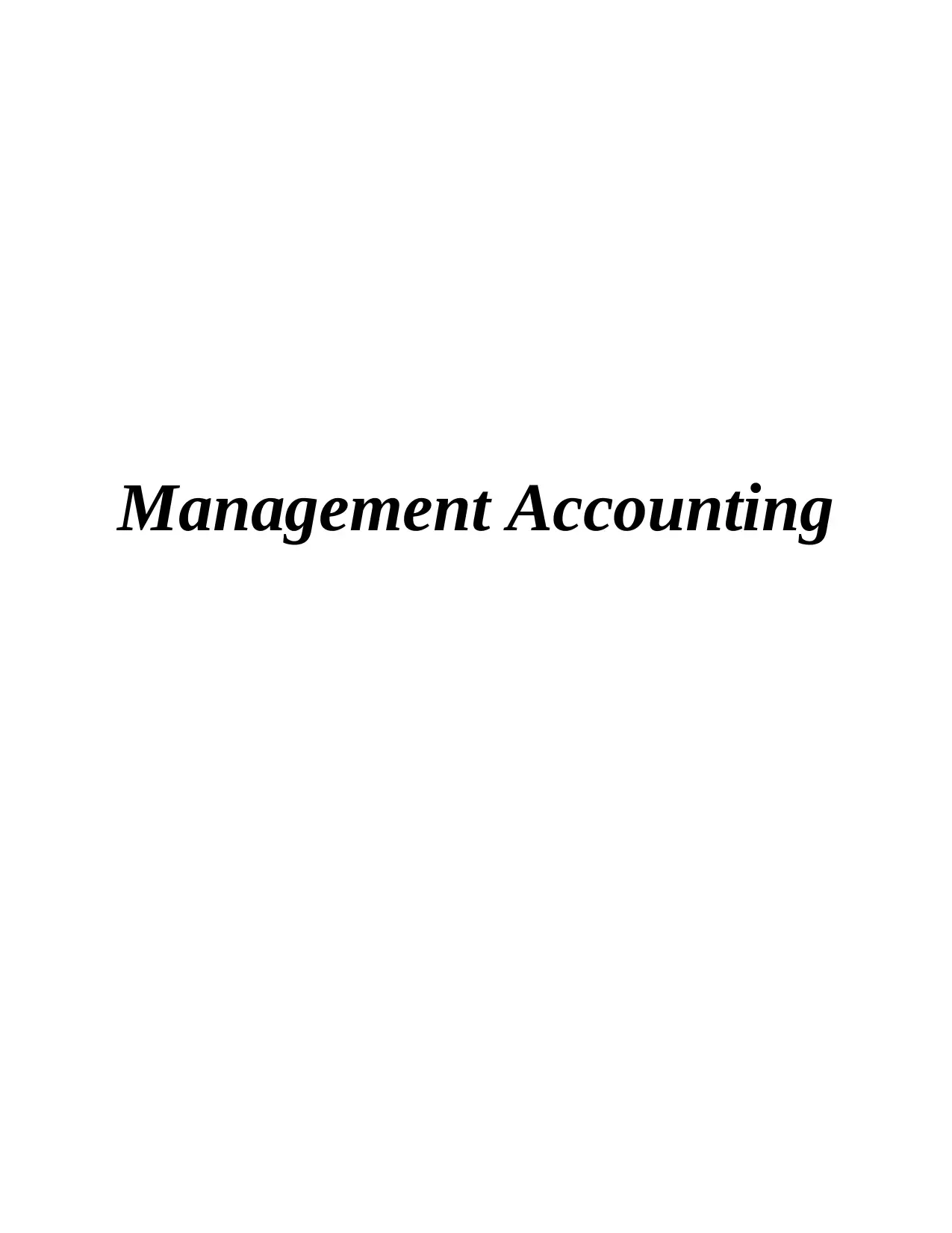
Management Accounting
Paraphrase This Document
Need a fresh take? Get an instant paraphrase of this document with our AI Paraphraser
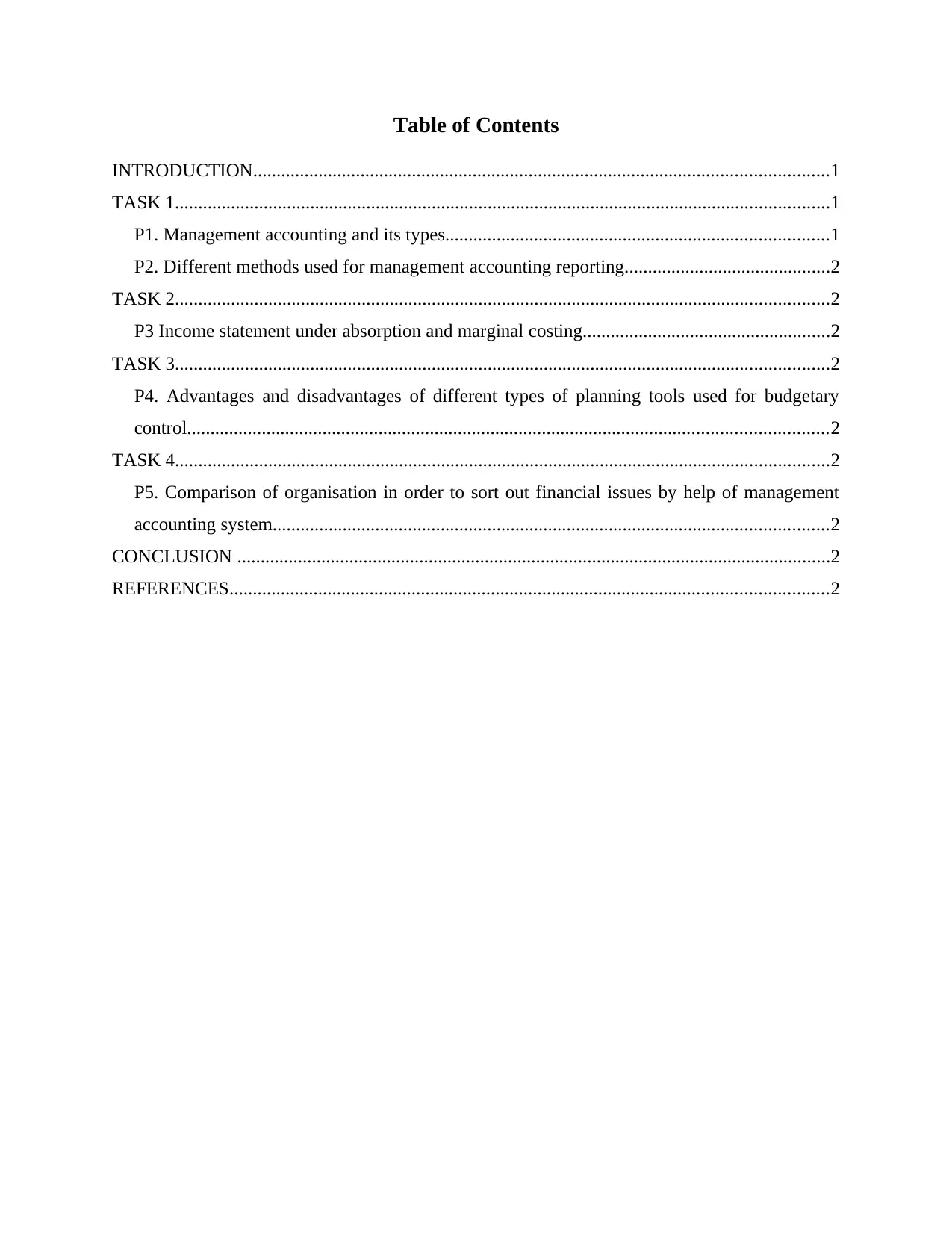
Table of Contents
INTRODUCTION...........................................................................................................................1
TASK 1............................................................................................................................................1
P1. Management accounting and its types..................................................................................1
P2. Different methods used for management accounting reporting............................................2
TASK 2............................................................................................................................................2
P3 Income statement under absorption and marginal costing.....................................................2
TASK 3............................................................................................................................................2
P4. Advantages and disadvantages of different types of planning tools used for budgetary
control.........................................................................................................................................2
TASK 4............................................................................................................................................2
P5. Comparison of organisation in order to sort out financial issues by help of management
accounting system.......................................................................................................................2
CONCLUSION ...............................................................................................................................2
REFERENCES................................................................................................................................2
INTRODUCTION...........................................................................................................................1
TASK 1............................................................................................................................................1
P1. Management accounting and its types..................................................................................1
P2. Different methods used for management accounting reporting............................................2
TASK 2............................................................................................................................................2
P3 Income statement under absorption and marginal costing.....................................................2
TASK 3............................................................................................................................................2
P4. Advantages and disadvantages of different types of planning tools used for budgetary
control.........................................................................................................................................2
TASK 4............................................................................................................................................2
P5. Comparison of organisation in order to sort out financial issues by help of management
accounting system.......................................................................................................................2
CONCLUSION ...............................................................................................................................2
REFERENCES................................................................................................................................2

⊘ This is a preview!⊘
Do you want full access?
Subscribe today to unlock all pages.

Trusted by 1+ million students worldwide
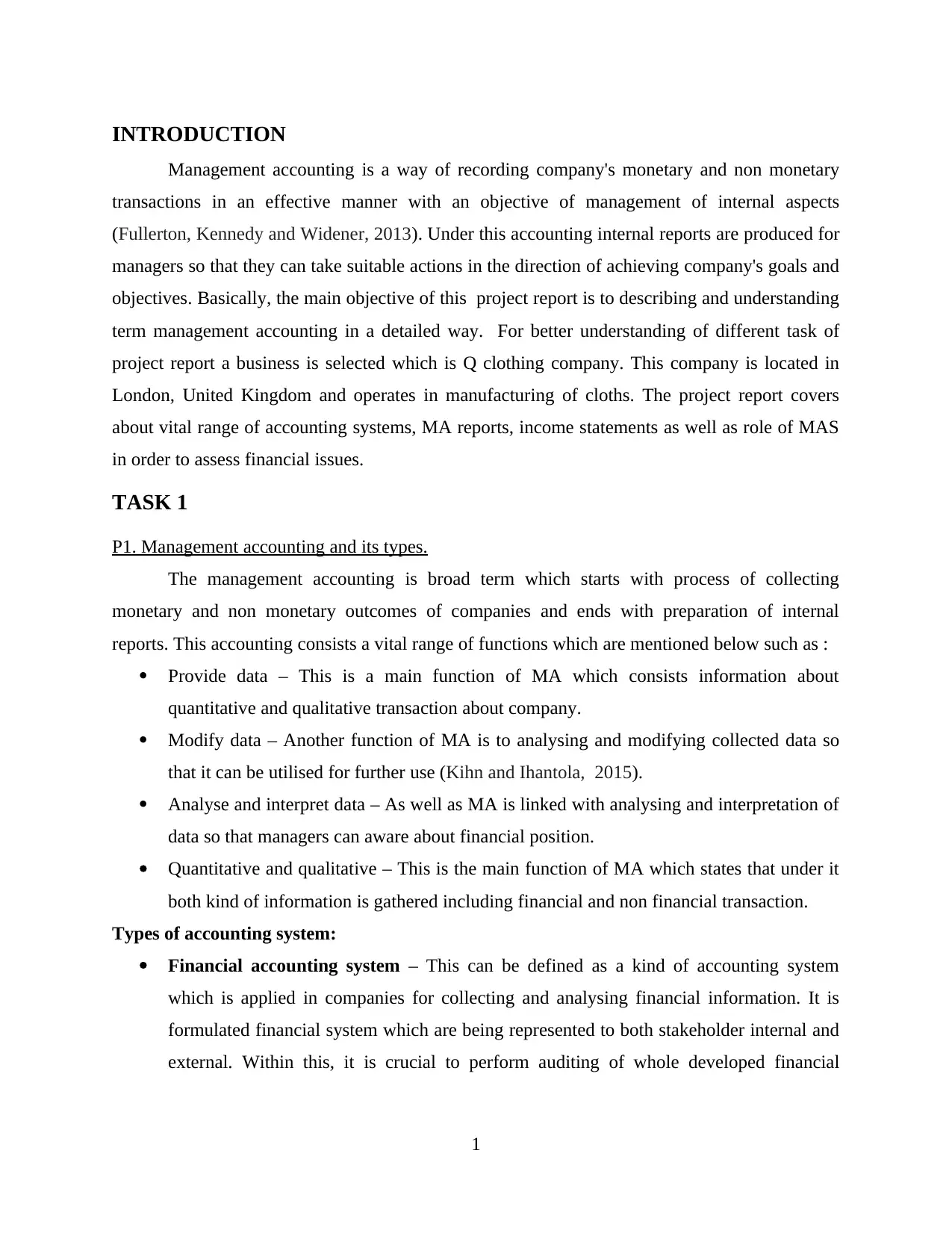
INTRODUCTION
Management accounting is a way of recording company's monetary and non monetary
transactions in an effective manner with an objective of management of internal aspects
(Fullerton, Kennedy and Widener, 2013). Under this accounting internal reports are produced for
managers so that they can take suitable actions in the direction of achieving company's goals and
objectives. Basically, the main objective of this project report is to describing and understanding
term management accounting in a detailed way. For better understanding of different task of
project report a business is selected which is Q clothing company. This company is located in
London, United Kingdom and operates in manufacturing of cloths. The project report covers
about vital range of accounting systems, MA reports, income statements as well as role of MAS
in order to assess financial issues.
TASK 1
P1. Management accounting and its types.
The management accounting is broad term which starts with process of collecting
monetary and non monetary outcomes of companies and ends with preparation of internal
reports. This accounting consists a vital range of functions which are mentioned below such as :
Provide data – This is a main function of MA which consists information about
quantitative and qualitative transaction about company.
Modify data – Another function of MA is to analysing and modifying collected data so
that it can be utilised for further use (Kihn and Ihantola, 2015).
Analyse and interpret data – As well as MA is linked with analysing and interpretation of
data so that managers can aware about financial position.
Quantitative and qualitative – This is the main function of MA which states that under it
both kind of information is gathered including financial and non financial transaction.
Types of accounting system:
Financial accounting system – This can be defined as a kind of accounting system
which is applied in companies for collecting and analysing financial information. It is
formulated financial system which are being represented to both stakeholder internal and
external. Within this, it is crucial to perform auditing of whole developed financial
1
Management accounting is a way of recording company's monetary and non monetary
transactions in an effective manner with an objective of management of internal aspects
(Fullerton, Kennedy and Widener, 2013). Under this accounting internal reports are produced for
managers so that they can take suitable actions in the direction of achieving company's goals and
objectives. Basically, the main objective of this project report is to describing and understanding
term management accounting in a detailed way. For better understanding of different task of
project report a business is selected which is Q clothing company. This company is located in
London, United Kingdom and operates in manufacturing of cloths. The project report covers
about vital range of accounting systems, MA reports, income statements as well as role of MAS
in order to assess financial issues.
TASK 1
P1. Management accounting and its types.
The management accounting is broad term which starts with process of collecting
monetary and non monetary outcomes of companies and ends with preparation of internal
reports. This accounting consists a vital range of functions which are mentioned below such as :
Provide data – This is a main function of MA which consists information about
quantitative and qualitative transaction about company.
Modify data – Another function of MA is to analysing and modifying collected data so
that it can be utilised for further use (Kihn and Ihantola, 2015).
Analyse and interpret data – As well as MA is linked with analysing and interpretation of
data so that managers can aware about financial position.
Quantitative and qualitative – This is the main function of MA which states that under it
both kind of information is gathered including financial and non financial transaction.
Types of accounting system:
Financial accounting system – This can be defined as a kind of accounting system
which is applied in companies for collecting and analysing financial information. It is
formulated financial system which are being represented to both stakeholder internal and
external. Within this, it is crucial to perform auditing of whole developed financial
1
Paraphrase This Document
Need a fresh take? Get an instant paraphrase of this document with our AI Paraphraser
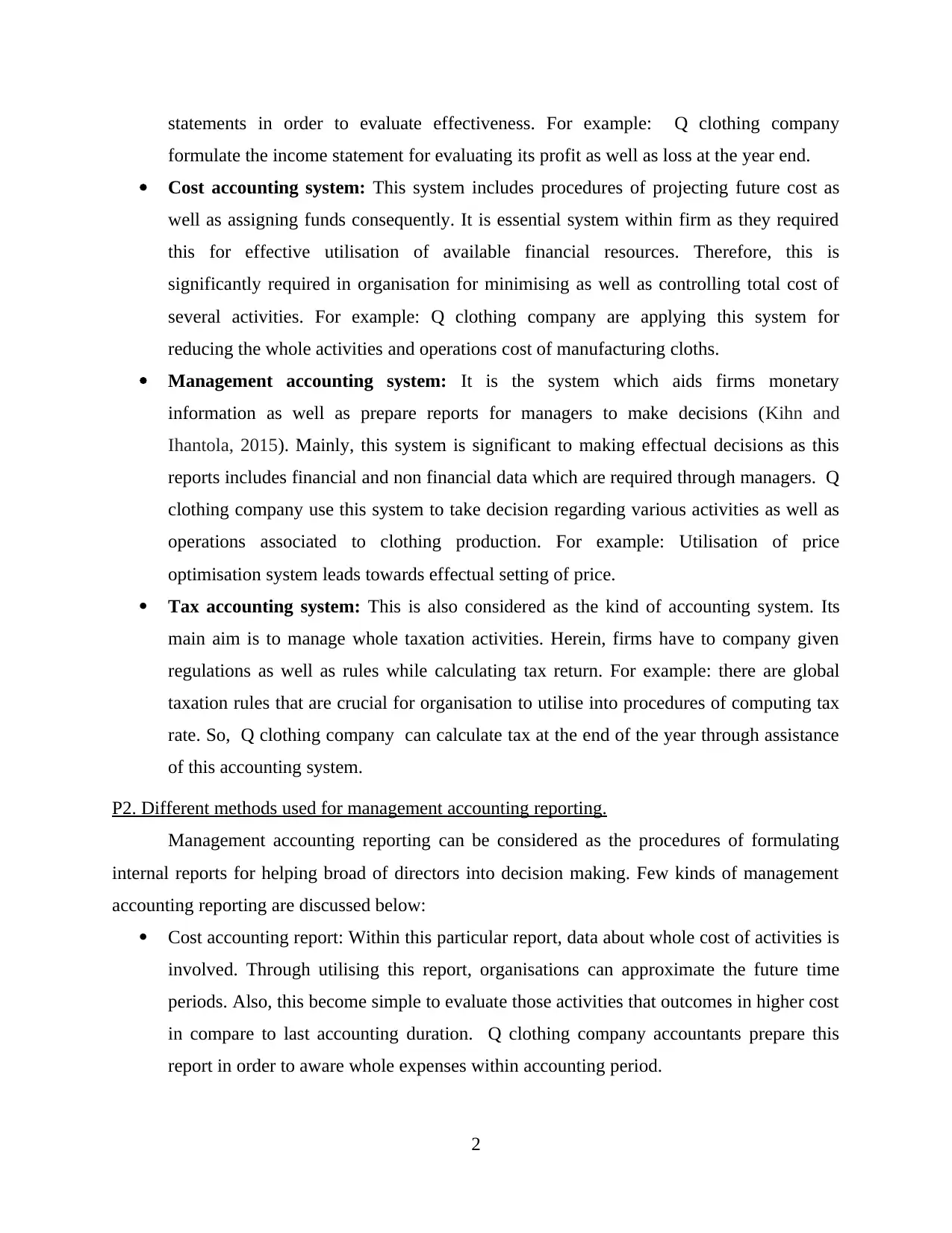
statements in order to evaluate effectiveness. For example: Q clothing company
formulate the income statement for evaluating its profit as well as loss at the year end.
Cost accounting system: This system includes procedures of projecting future cost as
well as assigning funds consequently. It is essential system within firm as they required
this for effective utilisation of available financial resources. Therefore, this is
significantly required in organisation for minimising as well as controlling total cost of
several activities. For example: Q clothing company are applying this system for
reducing the whole activities and operations cost of manufacturing cloths.
Management accounting system: It is the system which aids firms monetary
information as well as prepare reports for managers to make decisions (Kihn and
Ihantola, 2015). Mainly, this system is significant to making effectual decisions as this
reports includes financial and non financial data which are required through managers. Q
clothing company use this system to take decision regarding various activities as well as
operations associated to clothing production. For example: Utilisation of price
optimisation system leads towards effectual setting of price.
Tax accounting system: This is also considered as the kind of accounting system. Its
main aim is to manage whole taxation activities. Herein, firms have to company given
regulations as well as rules while calculating tax return. For example: there are global
taxation rules that are crucial for organisation to utilise into procedures of computing tax
rate. So, Q clothing company can calculate tax at the end of the year through assistance
of this accounting system.
P2. Different methods used for management accounting reporting.
Management accounting reporting can be considered as the procedures of formulating
internal reports for helping broad of directors into decision making. Few kinds of management
accounting reporting are discussed below:
Cost accounting report: Within this particular report, data about whole cost of activities is
involved. Through utilising this report, organisations can approximate the future time
periods. Also, this become simple to evaluate those activities that outcomes in higher cost
in compare to last accounting duration. Q clothing company accountants prepare this
report in order to aware whole expenses within accounting period.
2
formulate the income statement for evaluating its profit as well as loss at the year end.
Cost accounting system: This system includes procedures of projecting future cost as
well as assigning funds consequently. It is essential system within firm as they required
this for effective utilisation of available financial resources. Therefore, this is
significantly required in organisation for minimising as well as controlling total cost of
several activities. For example: Q clothing company are applying this system for
reducing the whole activities and operations cost of manufacturing cloths.
Management accounting system: It is the system which aids firms monetary
information as well as prepare reports for managers to make decisions (Kihn and
Ihantola, 2015). Mainly, this system is significant to making effectual decisions as this
reports includes financial and non financial data which are required through managers. Q
clothing company use this system to take decision regarding various activities as well as
operations associated to clothing production. For example: Utilisation of price
optimisation system leads towards effectual setting of price.
Tax accounting system: This is also considered as the kind of accounting system. Its
main aim is to manage whole taxation activities. Herein, firms have to company given
regulations as well as rules while calculating tax return. For example: there are global
taxation rules that are crucial for organisation to utilise into procedures of computing tax
rate. So, Q clothing company can calculate tax at the end of the year through assistance
of this accounting system.
P2. Different methods used for management accounting reporting.
Management accounting reporting can be considered as the procedures of formulating
internal reports for helping broad of directors into decision making. Few kinds of management
accounting reporting are discussed below:
Cost accounting report: Within this particular report, data about whole cost of activities is
involved. Through utilising this report, organisations can approximate the future time
periods. Also, this become simple to evaluate those activities that outcomes in higher cost
in compare to last accounting duration. Q clothing company accountants prepare this
report in order to aware whole expenses within accounting period.
2
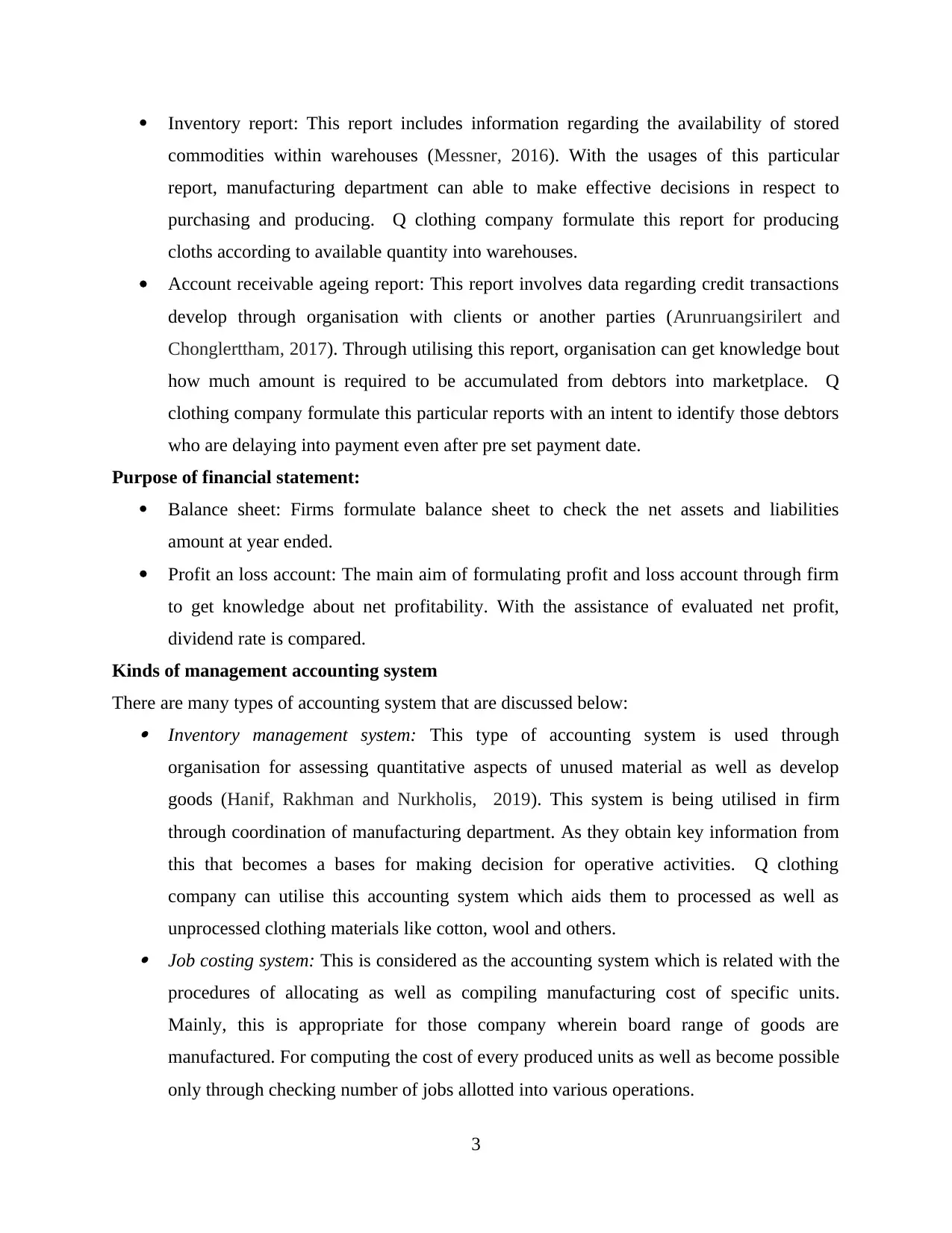
Inventory report: This report includes information regarding the availability of stored
commodities within warehouses (Messner, 2016). With the usages of this particular
report, manufacturing department can able to make effective decisions in respect to
purchasing and producing. Q clothing company formulate this report for producing
cloths according to available quantity into warehouses.
Account receivable ageing report: This report involves data regarding credit transactions
develop through organisation with clients or another parties (Arunruangsirilert and
Chonglerttham, 2017). Through utilising this report, organisation can get knowledge bout
how much amount is required to be accumulated from debtors into marketplace. Q
clothing company formulate this particular reports with an intent to identify those debtors
who are delaying into payment even after pre set payment date.
Purpose of financial statement:
Balance sheet: Firms formulate balance sheet to check the net assets and liabilities
amount at year ended.
Profit an loss account: The main aim of formulating profit and loss account through firm
to get knowledge about net profitability. With the assistance of evaluated net profit,
dividend rate is compared.
Kinds of management accounting system
There are many types of accounting system that are discussed below: Inventory management system: This type of accounting system is used through
organisation for assessing quantitative aspects of unused material as well as develop
goods (Hanif, Rakhman and Nurkholis, 2019). This system is being utilised in firm
through coordination of manufacturing department. As they obtain key information from
this that becomes a bases for making decision for operative activities. Q clothing
company can utilise this accounting system which aids them to processed as well as
unprocessed clothing materials like cotton, wool and others. Job costing system: This is considered as the accounting system which is related with the
procedures of allocating as well as compiling manufacturing cost of specific units.
Mainly, this is appropriate for those company wherein board range of goods are
manufactured. For computing the cost of every produced units as well as become possible
only through checking number of jobs allotted into various operations.
3
commodities within warehouses (Messner, 2016). With the usages of this particular
report, manufacturing department can able to make effective decisions in respect to
purchasing and producing. Q clothing company formulate this report for producing
cloths according to available quantity into warehouses.
Account receivable ageing report: This report involves data regarding credit transactions
develop through organisation with clients or another parties (Arunruangsirilert and
Chonglerttham, 2017). Through utilising this report, organisation can get knowledge bout
how much amount is required to be accumulated from debtors into marketplace. Q
clothing company formulate this particular reports with an intent to identify those debtors
who are delaying into payment even after pre set payment date.
Purpose of financial statement:
Balance sheet: Firms formulate balance sheet to check the net assets and liabilities
amount at year ended.
Profit an loss account: The main aim of formulating profit and loss account through firm
to get knowledge about net profitability. With the assistance of evaluated net profit,
dividend rate is compared.
Kinds of management accounting system
There are many types of accounting system that are discussed below: Inventory management system: This type of accounting system is used through
organisation for assessing quantitative aspects of unused material as well as develop
goods (Hanif, Rakhman and Nurkholis, 2019). This system is being utilised in firm
through coordination of manufacturing department. As they obtain key information from
this that becomes a bases for making decision for operative activities. Q clothing
company can utilise this accounting system which aids them to processed as well as
unprocessed clothing materials like cotton, wool and others. Job costing system: This is considered as the accounting system which is related with the
procedures of allocating as well as compiling manufacturing cost of specific units.
Mainly, this is appropriate for those company wherein board range of goods are
manufactured. For computing the cost of every produced units as well as become possible
only through checking number of jobs allotted into various operations.
3
⊘ This is a preview!⊘
Do you want full access?
Subscribe today to unlock all pages.

Trusted by 1+ million students worldwide
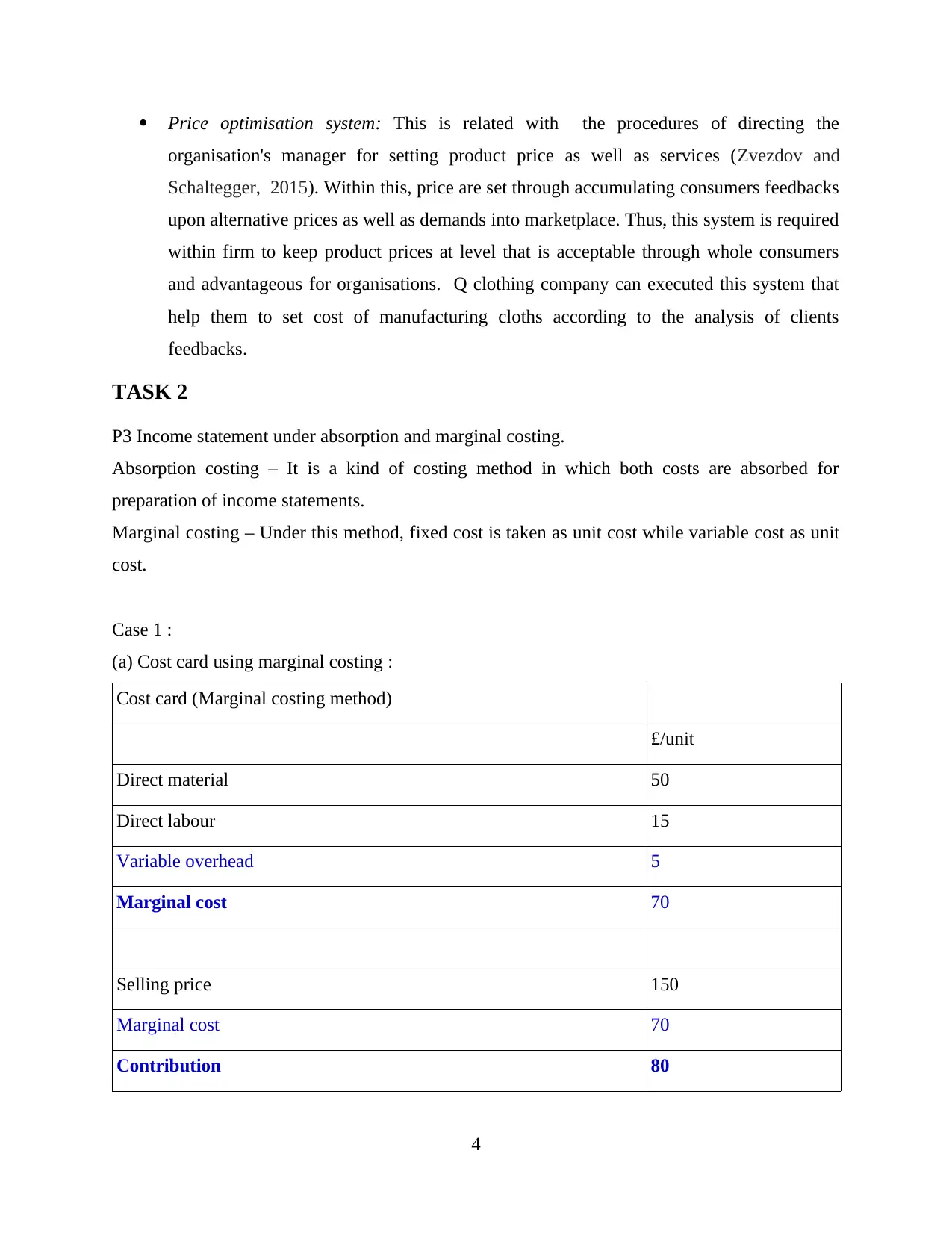
Price optimisation system: This is related with the procedures of directing the
organisation's manager for setting product price as well as services (Zvezdov and
Schaltegger, 2015). Within this, price are set through accumulating consumers feedbacks
upon alternative prices as well as demands into marketplace. Thus, this system is required
within firm to keep product prices at level that is acceptable through whole consumers
and advantageous for organisations. Q clothing company can executed this system that
help them to set cost of manufacturing cloths according to the analysis of clients
feedbacks.
TASK 2
P3 Income statement under absorption and marginal costing.
Absorption costing – It is a kind of costing method in which both costs are absorbed for
preparation of income statements.
Marginal costing – Under this method, fixed cost is taken as unit cost while variable cost as unit
cost.
Case 1 :
(a) Cost card using marginal costing :
Cost card (Marginal costing method)
£/unit
Direct material 50
Direct labour 15
Variable overhead 5
Marginal cost 70
Selling price 150
Marginal cost 70
Contribution 80
4
organisation's manager for setting product price as well as services (Zvezdov and
Schaltegger, 2015). Within this, price are set through accumulating consumers feedbacks
upon alternative prices as well as demands into marketplace. Thus, this system is required
within firm to keep product prices at level that is acceptable through whole consumers
and advantageous for organisations. Q clothing company can executed this system that
help them to set cost of manufacturing cloths according to the analysis of clients
feedbacks.
TASK 2
P3 Income statement under absorption and marginal costing.
Absorption costing – It is a kind of costing method in which both costs are absorbed for
preparation of income statements.
Marginal costing – Under this method, fixed cost is taken as unit cost while variable cost as unit
cost.
Case 1 :
(a) Cost card using marginal costing :
Cost card (Marginal costing method)
£/unit
Direct material 50
Direct labour 15
Variable overhead 5
Marginal cost 70
Selling price 150
Marginal cost 70
Contribution 80
4
Paraphrase This Document
Need a fresh take? Get an instant paraphrase of this document with our AI Paraphraser

(b) Profit and loss account:
Profit and loss statement for month of January:
Particulars DR CR
Sales revenue (12000 * 150) 1800000
Direct material (15000*50) 750000
Direct labour (15000*15) 225000
Variable cost (15000*5) 75000
Fixed production overhead 30000
Less : Closing stock (3000*70) 210000
Less: Cost of sales 870000
Profit 930000
Profit and loss statement for month of February
Particulars DR CR
Sales revenue (14000 * 150) 2100000
Direct material (12000*50) 600000
Direct labour (12000*15) 180000
Variable cost (12000*5) 60000
Add : Opening stock (3000*70) 210000
Fixed production overhead 24000
Less- Closing stock (1000*70) 70000
Less: Cost of sales 1004000
Profit 1096000
5
Profit and loss statement for month of January:
Particulars DR CR
Sales revenue (12000 * 150) 1800000
Direct material (15000*50) 750000
Direct labour (15000*15) 225000
Variable cost (15000*5) 75000
Fixed production overhead 30000
Less : Closing stock (3000*70) 210000
Less: Cost of sales 870000
Profit 930000
Profit and loss statement for month of February
Particulars DR CR
Sales revenue (14000 * 150) 2100000
Direct material (12000*50) 600000
Direct labour (12000*15) 180000
Variable cost (12000*5) 60000
Add : Opening stock (3000*70) 210000
Fixed production overhead 24000
Less- Closing stock (1000*70) 70000
Less: Cost of sales 1004000
Profit 1096000
5
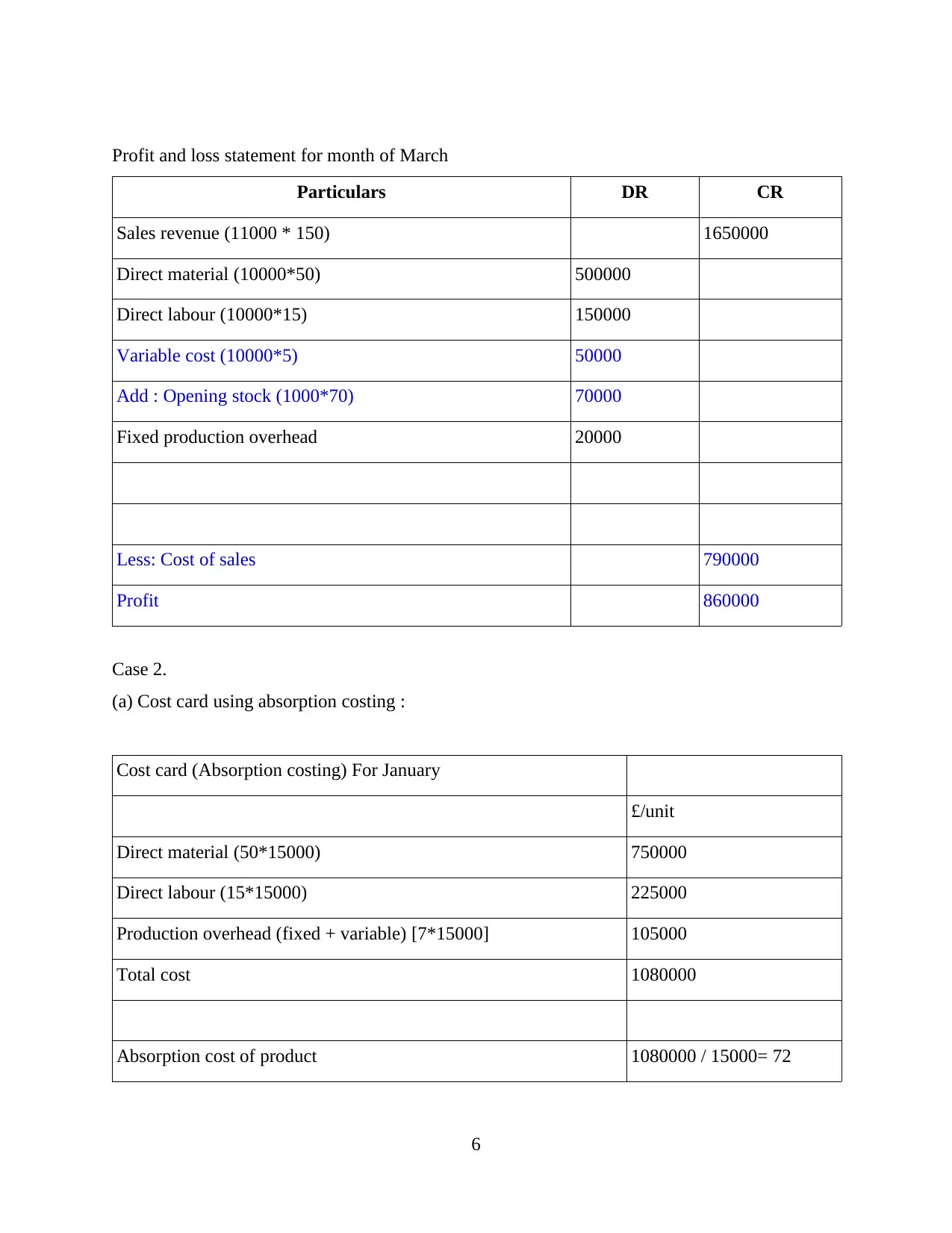
Profit and loss statement for month of March
Particulars DR CR
Sales revenue (11000 * 150) 1650000
Direct material (10000*50) 500000
Direct labour (10000*15) 150000
Variable cost (10000*5) 50000
Add : Opening stock (1000*70) 70000
Fixed production overhead 20000
Less: Cost of sales 790000
Profit 860000
Case 2.
(a) Cost card using absorption costing :
Cost card (Absorption costing) For January
£/unit
Direct material (50*15000) 750000
Direct labour (15*15000) 225000
Production overhead (fixed + variable) [7*15000] 105000
Total cost 1080000
Absorption cost of product 1080000 / 15000= 72
6
Particulars DR CR
Sales revenue (11000 * 150) 1650000
Direct material (10000*50) 500000
Direct labour (10000*15) 150000
Variable cost (10000*5) 50000
Add : Opening stock (1000*70) 70000
Fixed production overhead 20000
Less: Cost of sales 790000
Profit 860000
Case 2.
(a) Cost card using absorption costing :
Cost card (Absorption costing) For January
£/unit
Direct material (50*15000) 750000
Direct labour (15*15000) 225000
Production overhead (fixed + variable) [7*15000] 105000
Total cost 1080000
Absorption cost of product 1080000 / 15000= 72
6
⊘ This is a preview!⊘
Do you want full access?
Subscribe today to unlock all pages.

Trusted by 1+ million students worldwide
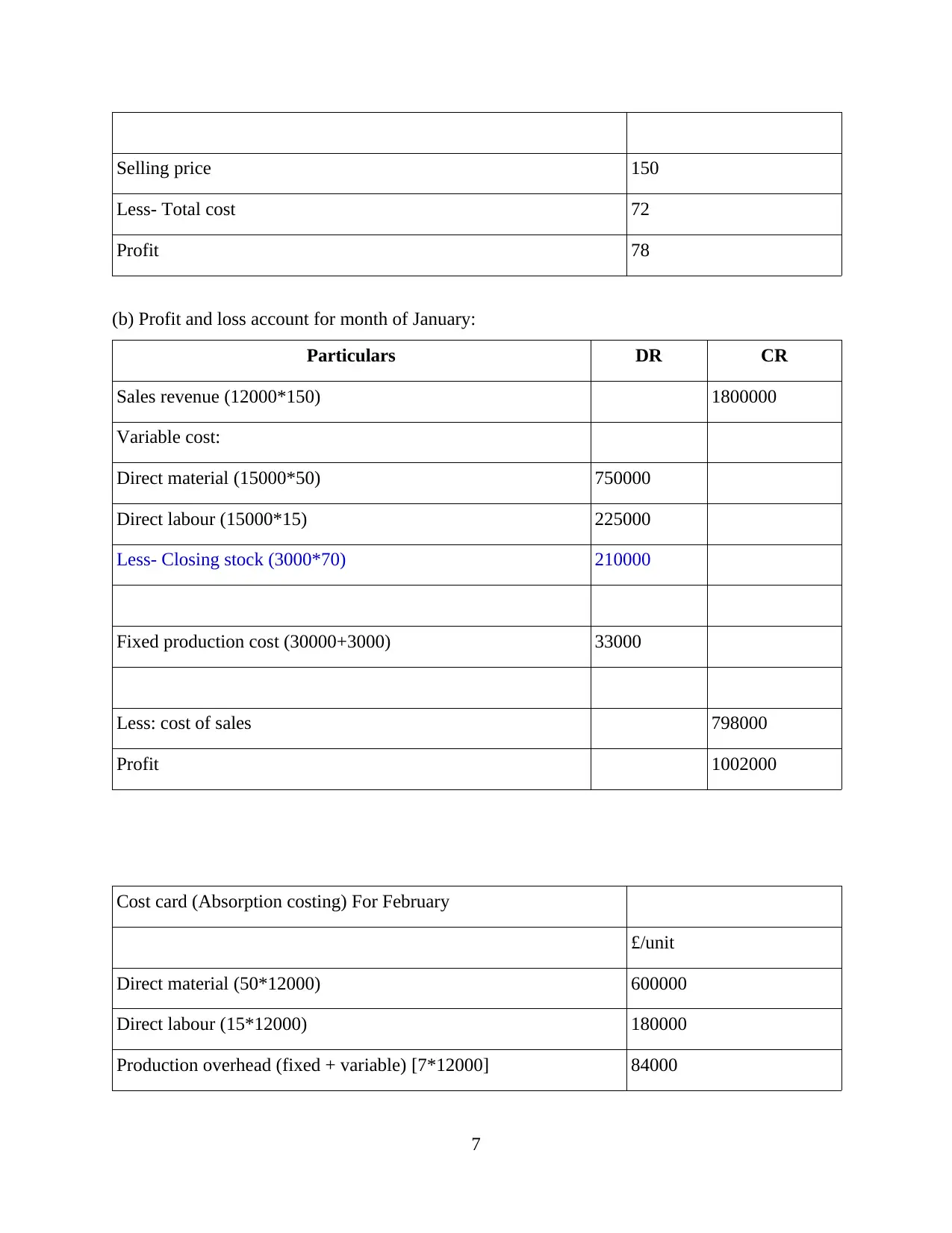
Selling price 150
Less- Total cost 72
Profit 78
(b) Profit and loss account for month of January:
Particulars DR CR
Sales revenue (12000*150) 1800000
Variable cost:
Direct material (15000*50) 750000
Direct labour (15000*15) 225000
Less- Closing stock (3000*70) 210000
Fixed production cost (30000+3000) 33000
Less: cost of sales 798000
Profit 1002000
Cost card (Absorption costing) For February
£/unit
Direct material (50*12000) 600000
Direct labour (15*12000) 180000
Production overhead (fixed + variable) [7*12000] 84000
7
Less- Total cost 72
Profit 78
(b) Profit and loss account for month of January:
Particulars DR CR
Sales revenue (12000*150) 1800000
Variable cost:
Direct material (15000*50) 750000
Direct labour (15000*15) 225000
Less- Closing stock (3000*70) 210000
Fixed production cost (30000+3000) 33000
Less: cost of sales 798000
Profit 1002000
Cost card (Absorption costing) For February
£/unit
Direct material (50*12000) 600000
Direct labour (15*12000) 180000
Production overhead (fixed + variable) [7*12000] 84000
7
Paraphrase This Document
Need a fresh take? Get an instant paraphrase of this document with our AI Paraphraser
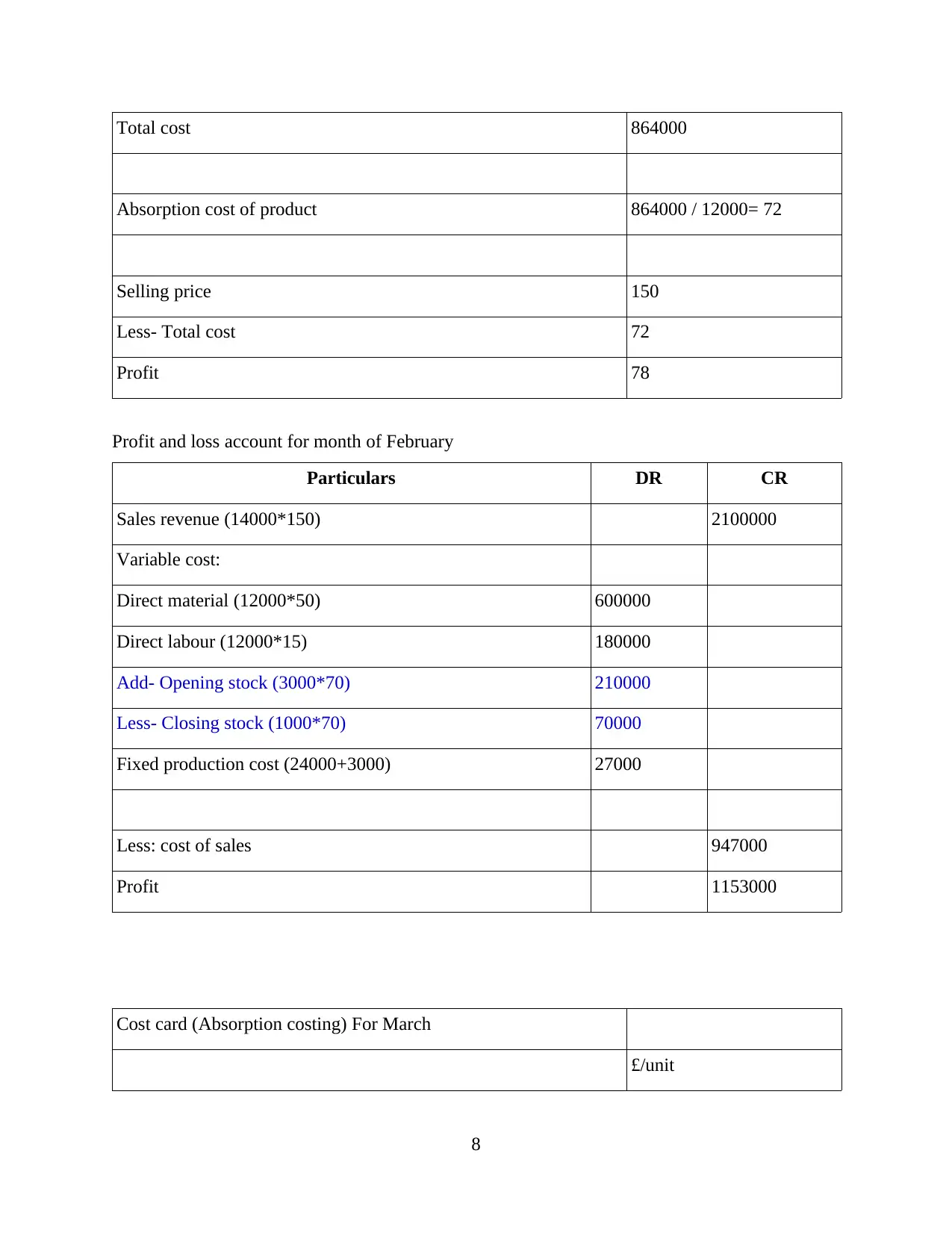
Total cost 864000
Absorption cost of product 864000 / 12000= 72
Selling price 150
Less- Total cost 72
Profit 78
Profit and loss account for month of February
Particulars DR CR
Sales revenue (14000*150) 2100000
Variable cost:
Direct material (12000*50) 600000
Direct labour (12000*15) 180000
Add- Opening stock (3000*70) 210000
Less- Closing stock (1000*70) 70000
Fixed production cost (24000+3000) 27000
Less: cost of sales 947000
Profit 1153000
Cost card (Absorption costing) For March
£/unit
8
Absorption cost of product 864000 / 12000= 72
Selling price 150
Less- Total cost 72
Profit 78
Profit and loss account for month of February
Particulars DR CR
Sales revenue (14000*150) 2100000
Variable cost:
Direct material (12000*50) 600000
Direct labour (12000*15) 180000
Add- Opening stock (3000*70) 210000
Less- Closing stock (1000*70) 70000
Fixed production cost (24000+3000) 27000
Less: cost of sales 947000
Profit 1153000
Cost card (Absorption costing) For March
£/unit
8
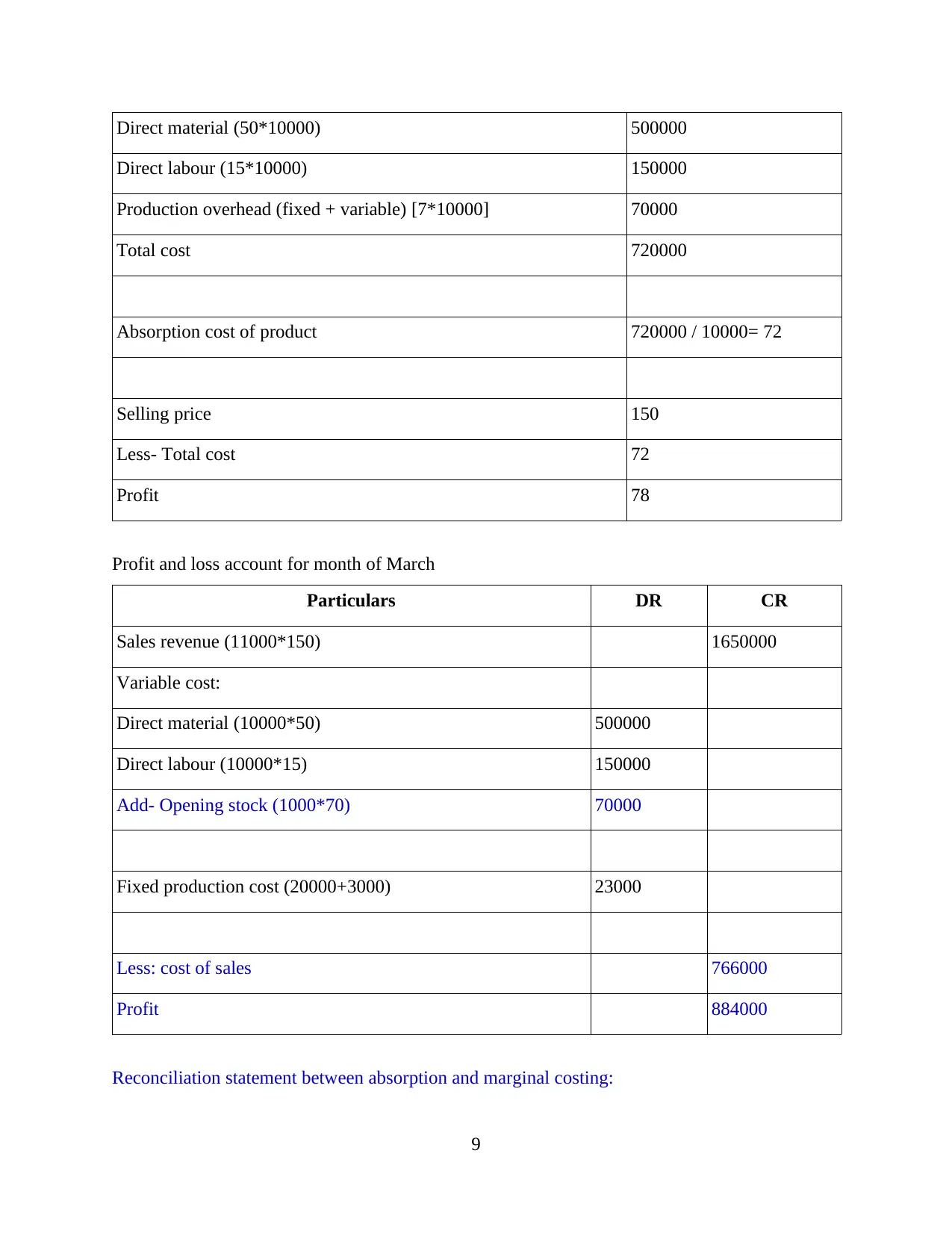
Direct material (50*10000) 500000
Direct labour (15*10000) 150000
Production overhead (fixed + variable) [7*10000] 70000
Total cost 720000
Absorption cost of product 720000 / 10000= 72
Selling price 150
Less- Total cost 72
Profit 78
Profit and loss account for month of March
Particulars DR CR
Sales revenue (11000*150) 1650000
Variable cost:
Direct material (10000*50) 500000
Direct labour (10000*15) 150000
Add- Opening stock (1000*70) 70000
Fixed production cost (20000+3000) 23000
Less: cost of sales 766000
Profit 884000
Reconciliation statement between absorption and marginal costing:
9
Direct labour (15*10000) 150000
Production overhead (fixed + variable) [7*10000] 70000
Total cost 720000
Absorption cost of product 720000 / 10000= 72
Selling price 150
Less- Total cost 72
Profit 78
Profit and loss account for month of March
Particulars DR CR
Sales revenue (11000*150) 1650000
Variable cost:
Direct material (10000*50) 500000
Direct labour (10000*15) 150000
Add- Opening stock (1000*70) 70000
Fixed production cost (20000+3000) 23000
Less: cost of sales 766000
Profit 884000
Reconciliation statement between absorption and marginal costing:
9
⊘ This is a preview!⊘
Do you want full access?
Subscribe today to unlock all pages.

Trusted by 1+ million students worldwide
1 out of 21
Related Documents
Your All-in-One AI-Powered Toolkit for Academic Success.
+13062052269
info@desklib.com
Available 24*7 on WhatsApp / Email
![[object Object]](/_next/static/media/star-bottom.7253800d.svg)
Unlock your academic potential
Copyright © 2020–2025 A2Z Services. All Rights Reserved. Developed and managed by ZUCOL.





